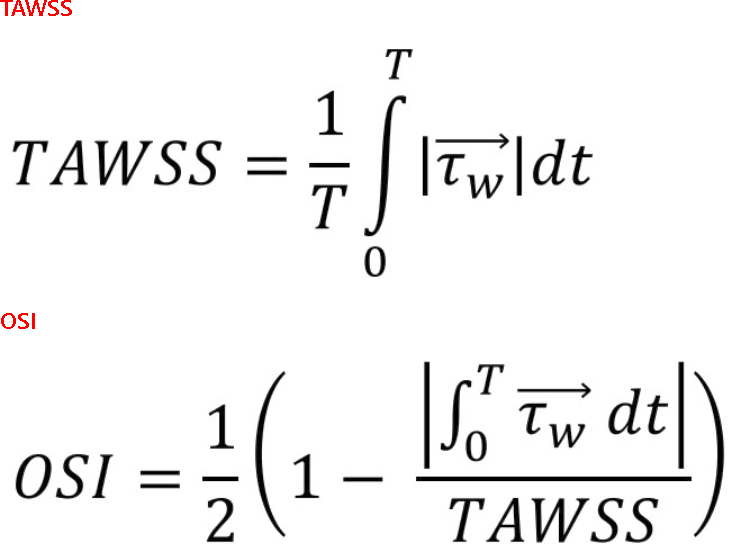-
-
January 28, 2024 at 2:24 am
amirz013
SubscriberGreetings,
I recently conducted some FSI simulations of an aortic valve using ANSYS LS-DYNA ICFD coupled with it's implicit structural solver. I have all the d3plot's saved and am able to load them into ANSYS EnSight.
A common metric that people in my field look at is called the time-averaged WSS (TAWSS) which is an integral over a cardiac cycle of the WSS magnitude of a particular surface. Similarly, we also look at a another wall metric called oscillatory shear index (OSI) which also has a time integral form. I've attached the equations below.
If the fluid surface was constant throughout the run, meaning no remeshing, theseformulas are easy to calculate using the provided TempMean and SpaMean functions as well as just by exporting the nodal data per time-step and then processing in MATLAB or Python.
However, since this is an FSI simulation, the severe deformations result in the ICFD solver undergoing 100s of remeshes. This changes the connectivity of the mesh each time and there is no clear way for me to calculate these temporal metrics now because the nodes of one time point don't relate to the next. There is a step during remeshing where the old variables are mapped to the new one but there is no details given on how the nodes of one mesh correspond to the nodes of the remeshed mesh.
EnSight does not allow the use of TempMean for meshes with changing connectivity, as highlighted in the manual.
Is there some way I could calculate these time-averaged metrics on a surface that changes mesh connectivity due to its deformation?
Thank You,
Asad
-
February 2, 2024 at 10:36 pm
Reno Genest
Ansys EmployeeHello Asad,
I am not familliar with TAWSS and OSI; what quantity do you need to calculate TAWSS and OSI? From the equations you provided above, it seems all you need is the shear stress at the wall as a function of time. Am I correct? If so, you can output the drag force on a surface part using *ICFD_DATABASE_DRAG in LS-DYNA. Then, you can calculate the shear stress. Have a look at the following post:
/forum/forums/topic/icfd-fsis-stress-output/#post-240433
Let me know if this helps or not.
Reno.
-
February 3, 2024 at 2:44 am
amirz013
SubscriberHey Reno,
Thank you for taking the time to answer this question!
It's good to know that *ICFD_DATABASE_DRAG would have calculated the drag for me, it's not vital since I already use EnSight's built in gradient and fluid shear stress calculator to calculate the same values. Those drag values are supposed to be used in the TAWSS and OSI formula (tw refers to the shear stresses).
My issue is having to integrate across time and space these drag terms on a surface. If the fluid surface was static then I could use EnSight's TempMean function to calculate the required metrics using those drag paramters, likely through some use of a custom equation. The issue is that those functions only work for static surfaces whose meshes don't change. The meshes on my surface, and thus their connectivity, changes since LS-DYNA conducts remeshing every few time steps since the surface is moving.
Is there some way I can do a temporal mean for a surface that is changing across time, and thus connectivity?
Best Wishes,
Asad
-
February 3, 2024 at 3:19 am
Reno Genest
Ansys EmployeeHello Asad,
Give the drag output a try in LS-Dyna.
Let me know how it goes.
Reno.
-
- The topic ‘Time-averaged Wall Metrics in EnSight from LS-DYNA FSI Results’ is closed to new replies.


- How do I get my hands on Ansys Rocky DEM
- Non-Intersected faces found for matching interface periodic-walls
- Unburnt Hydrocarbons contour in ANSYS FORTE for sector mesh
- Help: About the expression of turbulent viscosity in Realizable k-e model
- Script Error
- Mass Conservation Issue in Methane Pyrolysis Shock Tube Simulation
- Facing trouble regarding setting up boundary conditions for SOEC Modeling
- convergence issue for transonic flow
- Running ANSYS Fluent on a HPC Cluster
- Point exception in erosion calculation

-
1932
-
823
-
599
-
591
-
366

© 2025 Copyright ANSYS, Inc. All rights reserved.






